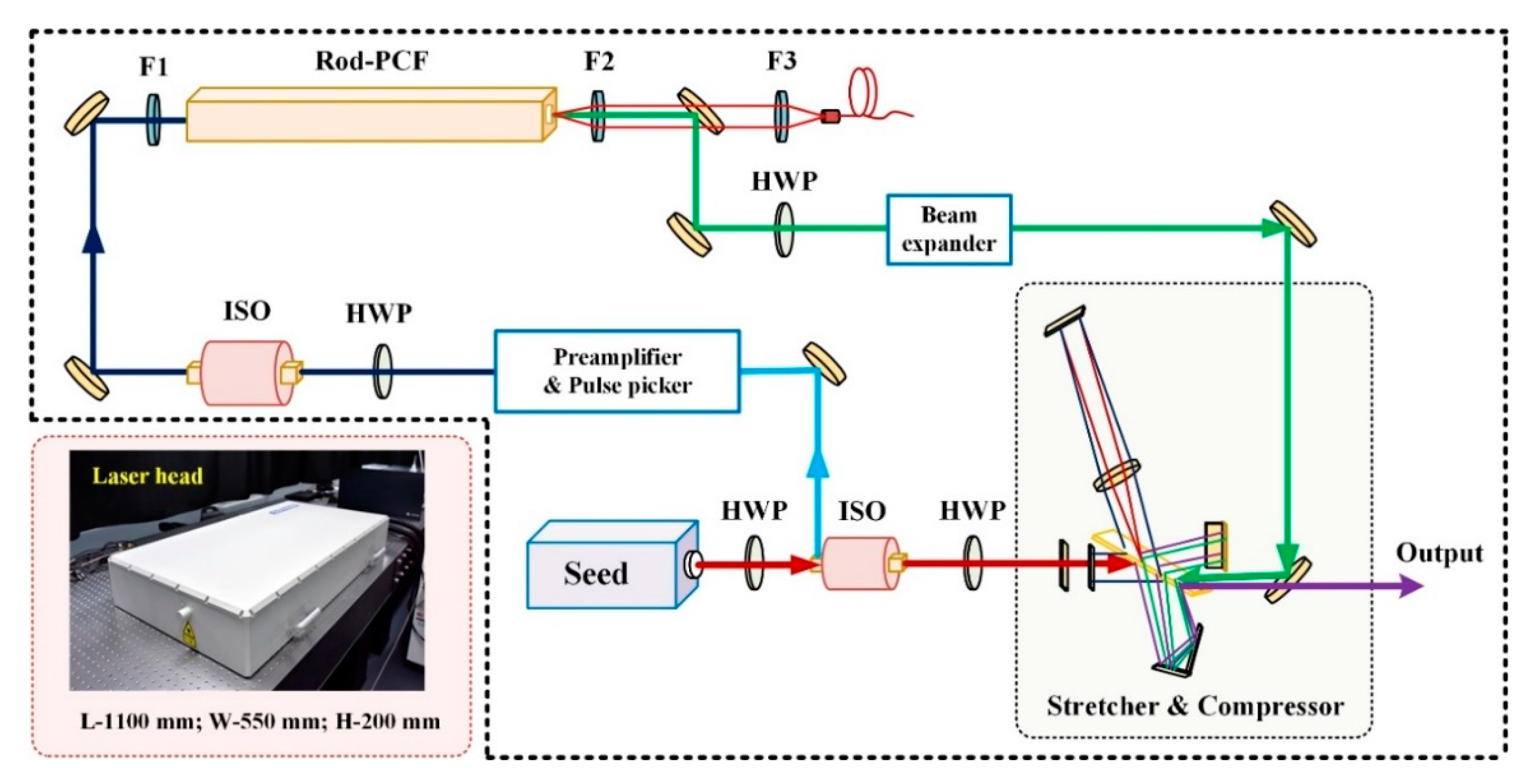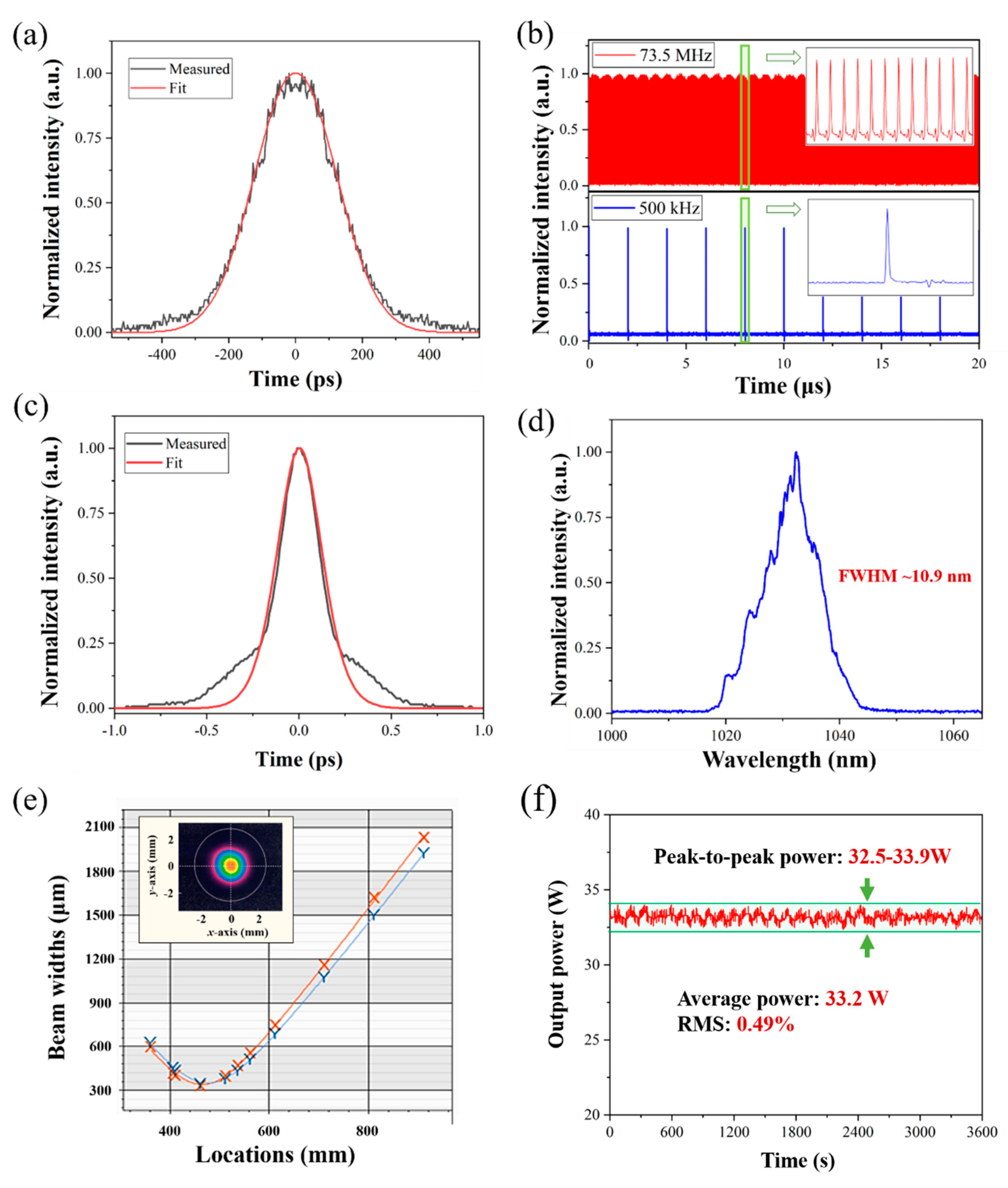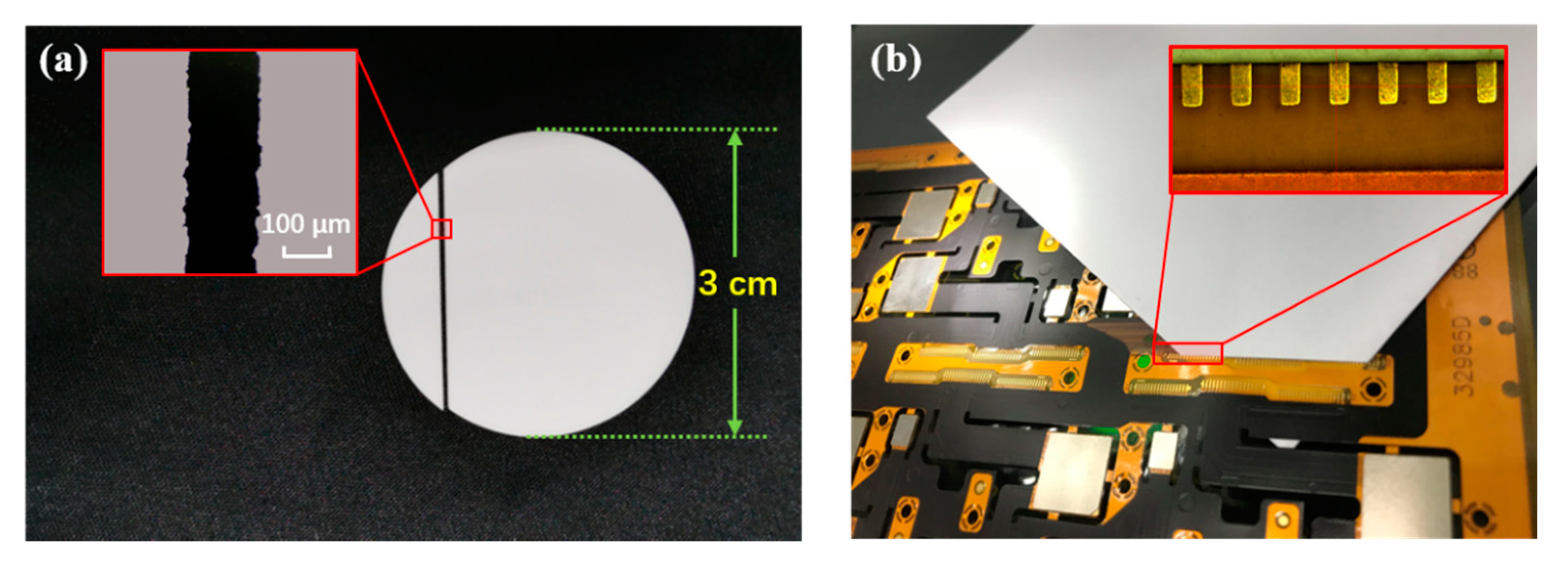A 33.2 W High Beam Quality Chirped-Pulse Amplification-Based Femtosecond Laser for Industrial Processing
Abstract
1. Introduction
2. High-Power Femtosecond Laser System
3. Laser Processing
4. Conclusions
Author Contributions
Funding
Conflicts of Interest
References
- Kafka, J.D.; Alfrey, A.J.; Baer, T. Mode-locked continuous wave titanium sapphire laser. Ultrafase Phenom. VI 1988, 48, 64. [Google Scholar]
- French, P.M.W.; Williams, J.A.R.; Taylor, J.R. Femtosecond pulse generation from a titanium-doped sapphire laser using nonlinear external cavity feedback. Opt. Lett. 1989, 14, 686–688. [Google Scholar] [CrossRef] [PubMed]
- Wang, X.C.; Zheng, H.Y.; Chu, P.L.; Tan, J.L.; Teh, K.M.; Liu, T.; Ang, B.C.; Tay, G.H. Femtosecond laser drilling of alumina ceramic substrates. Appl. Phys. A 2010, 101, 271–278. [Google Scholar] [CrossRef]
- Lanara, C.; Mimidis, A.; Stratakis, E. Femtosecond Laser Fabrication of Stable Hydrophilic and Anti-Corrosive Steel Surfaces. Materials 2019, 12, 3428. [Google Scholar] [CrossRef] [PubMed]
- Bharadwaj, V.; Wang, Y.; Fernandez, T.T.; Ramponi, R.; Eaton, S.M.; Galzerano, G. Femtosecond laser written diamond waveguides: A step towards integrated photonics in the far infrared. Opt. Mater. 2018, 85, 183–185. [Google Scholar] [CrossRef]
- Gattass, R.R.; Mazur, E. Femtosecond laser micromachining in transparent materials. Nat. Photonics 2008, 2, 219–225. [Google Scholar] [CrossRef]
- Tamaki, T.; Watanabe, W.; Nishii, J.; Itoh, K. Welding of Transparent Materials Using Femtosecond Laser Pulses. Jpn. J. Appl. Phys. 2005, 44, 687–689. [Google Scholar] [CrossRef]
- Chichkov, B.N.; Momma, C.; Nolte, S.; Von Alvensleben, F.; Tünnermann, A. Femtosecond, picosecond and nanosecond laser ablation of solids. Appl. Phys. A 1996, 63, 109–115. [Google Scholar] [CrossRef]
- Pronko, P.P.; Dutta, S.K.; Du, D.; Singh, R.K. Thermophysical effects in laser processing of materials with picosecond and femtosecond pulses. J. Appl. Phys. 1995, 78, 6233–6240. [Google Scholar] [CrossRef]
- Stoian, R.; Ashkenasi, D.; Rosenfeld, A.; Wittmann, M.; Kelly, R.; Campbell, E.E.B. The dynamics of ion expulsion in ultrashort pulse laser sputtering of Al2O3. Nuclear Instrum. Methods Phys. Res. Sect. B Beam Interact. Mater. Atoms 2000, 166, 682–690. [Google Scholar] [CrossRef]
- Rudolph, P.; Kautek, W. Composition influence of non-oxidic ceramics on self-assembled nanostructures due to fs-laser irradiation. Thin Solid Films 2004, 453, 537–541. [Google Scholar] [CrossRef]
- Dumitru, G.; Romano, V.; Weber, H.P.; Sentis, M.; Marine, W. Femtosecond ablation of ultrahard materials. Appl. Phys. A 2002, 74, 729–739. [Google Scholar] [CrossRef]
- Oraevsky, A.A.; Da Silva, L.B.; Rubenchik, A.M.; Feit, M.D.; Glinsky, M.E.; Perry, M.D.; Mammini, B.M.; Small, W.; Stuart, B.C. Plasma mediated ablation of biological tissues with nanosecond-to-femtosecond laser pulses: Relative role of linear and nonlinear absorption. IEEE J. Sel. Top. Quantum Electron. 1996, 2, 801–809. [Google Scholar] [CrossRef]
- Yanik, M.F.; Cinar, H.; Cinar, H.N.; Chisholm, A.D.; Jin, Y.; Ben-Yakar, A. Functional regeneration after laser axotomy. Nature 2004, 432, 822. [Google Scholar] [CrossRef] [PubMed]
- Çirkinoğlu, H.O.; Bayer, M.M.; Serpengüzel, A.; Rampini, S.; Sotillo, B.; Bharadwaj, V.; Ramponi, R.; Eaton, S.M. Femtosecond laser written diamond waveguide excitation of the whispering gallery modes in a silicon microsphere. Opt. Mater. 2019, 92, 418–424. [Google Scholar] [CrossRef]
- Keller, U.; Knox, W.H.; Cunningham, J.E. Femtosecond pulses from a continuously self-starting passively mode-locked Ti: Sapphire laser. Opt. Lett. 1991, 16, 1022–1024. [Google Scholar] [CrossRef]
- Bai, Z.; Bai, Z.; Kang, Z.; Lian, F.; Lin, W.; Fan, Z. Non-Pulse-Leakage 100-kHz Level, High Beam Quality Industrial Grade Nd:YVO4 Picosecond Amplifier. Appl. Sci. 2017, 7, 615. [Google Scholar] [CrossRef]
- Woodward, R.I.; Majewski, M.R.; Jackson, S.D. Mode-locked dysprosium fiber laser: Picosecond pulse generation from 2.97 to 3.30 μm. APL Photon. 2018, 3, 116106. [Google Scholar] [CrossRef]
- Zazali, N.A.; Latif, A.A.; Lau, K.Y.; Mahdi, M.A.; Muhammad, F.D.; Yusoff, Z.; Abdul-Rashid, H.A.; Radzi, N.M.; Tamchek, N.; Bakar, M.A. 860 femtoseconds mode-locked fiber laser by Gallium co-doped erbium fiber (Ga-EDF). Results Phys. 2019, 15, 102644. [Google Scholar] [CrossRef]
- Li, Z.; Dong, N.; Zhang, Y.; Wang, J.; Yu, H.; Chen, F. Mode-locked waveguide lasers modulated by rhenium diselenide as a new saturable absorber. APL Photon. 2018, 3, 080802. [Google Scholar] [CrossRef]
- Chan, C.C.K. Optical Performance Monitoring; Elsevier: Burlington, NJ, USA, 2010; pp. 193–221. [Google Scholar]
- Agrawal, G. Nonlinear Fiber Optics; Elsevier: Kidlington, UK, 2013. [Google Scholar]
- Liu, B.W.; Hu, M.L.; Fang, X.H.; Wu, Y.Z.; Song, Y.J.; Chai, L.; Wang, C.Y.; Zheltikov, A.M. High-power wavelength-tunable photonic-crystal-fiber-based oscillator-amplifier-frequency-shifter femtosecond laser system and its applications for material microprocessing. Laser Phys. Lett. 2008, 6, 44. [Google Scholar] [CrossRef]
- Manchee, C.P.K.; Möller, J.; Miller, R.J.D. Highly stable, 100 W average power from fiber-based ultrafast laser system at 1030 nm based on single-pass photonic-crystal rod amplifier. Opt. Commun. 2019, 437, 6–10. [Google Scholar] [CrossRef]
- Röser, F.; Schimpf, D.; Schmidt, O.; Ortaç, B.; Rademaker, K.; Limpert, J.; Tünnermann, A. 90 W average power 100 μJ energy femtosecond fiber chirped-pulse amplification system. Opt. Lett. 2007, 32, 2230–2232. [Google Scholar] [CrossRef] [PubMed]
- Röser, F.; Eidam, T.; Rothhardt, J.; Schmidt, O.; Schimpf, D.N.; Limpert, J.; Tünnermann, A. Millijoule pulse energy high repetition rate femtosecond fiber chirped-pulse amplification system. Opt. Lett. 2007, 32, 3495–3497. [Google Scholar] [CrossRef] [PubMed]
- Hönninger, C.; Audouard, E. Multi-100-Watt Femtosecond Laser Perspectives. Laser Tech. J. 2018, 15, 50–53. [Google Scholar] [CrossRef]
- Industrial Laser Solutions. Available online: https://www.industrial-lasers.com/home/article/16489137/industrial-femtosecond-lasers-and-material-processing (accessed on 22 January 2019).



© 2020 by the authors. Licensee MDPI, Basel, Switzerland. This article is an open access article distributed under the terms and conditions of the Creative Commons Attribution (CC BY) license (http://creativecommons.org/licenses/by/4.0/).
Share and Cite
Bai, Z.; Bai, Z.; Sun, X.; Liang, Y.; Wang, K.; Jin, D.; Fan, Z. A 33.2 W High Beam Quality Chirped-Pulse Amplification-Based Femtosecond Laser for Industrial Processing. Materials 2020, 13, 2841. https://doi.org/10.3390/ma13122841
Bai Z, Bai Z, Sun X, Liang Y, Wang K, Jin D, Fan Z. A 33.2 W High Beam Quality Chirped-Pulse Amplification-Based Femtosecond Laser for Industrial Processing. Materials. 2020; 13(12):2841. https://doi.org/10.3390/ma13122841
Chicago/Turabian StyleBai, Zhenao, Zhenxu Bai, Xiaolong Sun, Yong Liang, Kun Wang, Duo Jin, and Zhongwei Fan. 2020. "A 33.2 W High Beam Quality Chirped-Pulse Amplification-Based Femtosecond Laser for Industrial Processing" Materials 13, no. 12: 2841. https://doi.org/10.3390/ma13122841
APA StyleBai, Z., Bai, Z., Sun, X., Liang, Y., Wang, K., Jin, D., & Fan, Z. (2020). A 33.2 W High Beam Quality Chirped-Pulse Amplification-Based Femtosecond Laser for Industrial Processing. Materials, 13(12), 2841. https://doi.org/10.3390/ma13122841





